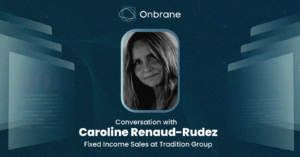Tradition Group is one of the early adopters of the Onbrane platform. Last week we had a conversation with Caroline Renaud-Rudez, Fixed Income Sales at Tradition. Caroline shared her experience dealing with market changes, how the Tradition group manages to maintain its leading position in the market, what’s her outlook on the future of CP markets, and of course, how their money market desk benefits from using Onbrane.
1. Caroline, let’s start by introducing yourself and also give us an overview of your role and responsibilities at Tradition.
After completing a Master’s in Financial Markets at Dauphine, I dedicated 15 years to the banking sector within the Agricole Group, specializing in interest-rate products as a sales professional. Following this, I spent 8 years at TP Icap before joining the Tradition Group, where I’ve been on the Money Market desk (0-5 years) for the past 4 years.
Throughout this period, I’ve witnessed various market cycles, including the 2008 financial crisis, as well as the subsequent cycles of interest rate fluctuations. I have also actively engaged with the latest regulatory developments and the implementation of ESG criteria in our organization.
2. As a money market broker, what sets you apart from the competition?
In the money market, distinguishing oneself from others is becoming increasingly challenging. Unlike other markets, the Commercial Paper (CP) market experiences more transparent flows. The primary market plays a significant role in daily activities, and we all have almost identical access to the same players (bank issuers, corporates), instruments, and market conditions (prices, maturity, etc.).
Moreover, CPs are often used for buy-and-hold investments, leading to reduced volatility. As we don’t have the option, like banks, to hold onto securities, we must prove our value as brokers through personalized client support, based on a relationship of trust, with the primary objective of working in their best interest.
We must serve as an information source, providing details to issuers about issuance levels and investor appetite, and informing investors about market liquidity, depth, and various observed flows. We also take care of optimizing investors’ resale prices and ensure fund liquidity, especially during cash outflows.
Another advantage of our positioning is having privileged access to many issuers, allowing us to conduct “reverse inquiries” after clearly identifying our clients’ needs.
Lastly, and crucially, our guiding principle that differentiates Tradition is to handle orders worth 1 million in the same manner as orders of 100 million and to always maintain maximum transparency.
3. From your perspective, what are the latest significant developments in the CP market? How have you observed the market evolving in recent times? (in terms of rate changes, market trends, ESG, data, digitalization)
The Commercial Paper (CP) market is undergoing constant evolution. As you know, starting in 2014, the ECB introduced an unconventional measure of negative benchmark interest rates to encourage banks and investors to lend more to the real economy, stimulate growth, and promote a recovery in inflation levels.
Despite concerns about outflows from money market funds to other forms of savings, monetary assets reached unprecedented levels during this period, demonstrating the resilience and attractiveness of this segment.
After 7 years of negative rates, we are finally entering a phase of rate hikes, further affirming the significance of this market (the combined outstanding of NEU CP and NEU MTN is at 334 billion euros as we speak!).
The regulatory environment (especially with MiFID) has arguably been one of the most significant developments in asset management, with client requirements and non-financial dimensions continually gaining importance.
The money market has withstood successive crises precisely because it is considered a secure and liquid investment. Regulatory changes and the integration of non-financial criteria contribute to strengthening this perception. For instance, a good ESG score enhances a company’s rating by agencies, ensuring better liquidity.
For over a year, the majority of monetary assets have had an ISR label and are managed with a socially responsible investment approach. Issuers are compelled to adjust their strategies and activities, such as developing green or sustainable CP programs.
Certainly, these regulations have completely disrupted portfolio management, often making it very cumbersome for managers. The preliminary process before making a CP investment decision has become lengthier, sometimes at the expense of missed market opportunities. However, this is arguably the price to pay for maintaining consistent performance without triggering “shocks” that are difficult to recover from.
From an execution standpoint, although we have witnessed the widespread implementation of controls and the almost universal adoption of trading desks in recent years, the money market still faces many challenges in modernization. The market is moving towards standardizing formats across geographical zones to enhance liquidity and depth.
This is why, for the past three to four years, we have seen the emergence of digital platforms striving towards this objective. While some struggled to find the optimal format to attract interest, Onbrane has successfully distinguished itself and emerged as a leader in the field.
4. With the recent rate hikes, how has the market changed for your company / your clients? Have there been any significant impacts on your decision-making process?
The shifts in investment behavior have been particularly noteworthy, I believe, during periods of negative interest rates. Negative rates have indeed prompted investors to seek higher yields in a less liquid asset class to generate more returns, leading to the entry of many new small corporate issuers into the market.
Furthermore, with the increase in assets and the implementation of new regulations, we observe a focus on “liquidity guarantee” from investors. While brokers were essential to ensuring liquidity during the 2008 crisis, we have recently witnessed a resurgence in the importance of banks in the Commercial Paper (CP) market.
Although the ability to hold securities and easily repurchase their debt gives dealer banks a significant advantage, I remain convinced of our added value and the necessity of a diverse set of actors in this market.
5. As a broker that has used our platform to negotiate CP, what were the key factors that influenced your decision to digitize your activities through Onbrane?
From the first touchpoint with Onbrane, I immediately established a positive connection with Etienne Vincent, your business developer. His dynamism and curiosity about our profession were clearly assets that initially motivated us to explore the project.
In contrast to some competitors, Onbrane incorporated brokers into the project from the beginning, fostering collaboration to ensure that all market participants benefit from the platform.
Consequently, we were able to highlight the advantages to some of our clients, and vice versa, Onbrane also helped us reach new counterparties with whom they already had a relationship!
I’d also add that we were one the first to place our trust in Onbrane, and we have confidently continued on this path.
While I don’t deny that initially there was concern about losing the client relationships to the total digitization of the profession, Onbrane managed to prove us otherwise. I believe the goal of this platform is not to replace the sellers but to assist and optimize the execution of operations.
6. Can you highlight any additional features or functionalities of the Onbrane platform that have proven particularly valuable in supporting your activities? How have these features enhanced your user experience?
As of today, we are utilizing the platform to negotiate with a few issuers. We appreciate the speed of execution we achieve with Onbrane and, of course, the rapid acquisition of the ISIN code via the platform’s API connection with Euroclear. I’d also add that the platform is very user-friendly and straightforward.
Another highly valued feature for me is the “ISIN library”, part of your data module, which contains all the ISIN codes of transactions processed in the market (even outside the platform) in real-time. This feature provides us with a comprehensive overview of all market flows and helps us quickly assess our market share in the deals of the day. Ultimately, it gives us a landscape of the average durations traded in the market.
7. For newcomers looking to digitize their activities on Onbrane, what advice would you give them based on your experience?
I would tell them that the trend towards digitization is inevitable (the money market is one of the last markets without platforms), and therefore, we must seek to evolve our profession as well by working smartly together so that everyone can benefit from these advances. This is the case with the Onbrane team, with whom we have established a genuine relationship.
8. How do you see the digitization of this market evolving in the future?
I believe regulations will continue with the aim of making this market segment even safer and more liquid. For example, some high-quality CPs could be considered HQLA and eligible for the LCR ratio, and money market funds might undergo an “exit fees” system. However, it is essential to hope that all of this, in the long run, does not become a barrier to the survival of a variety of actors and a hindrance to active management that could become too cumbersome from an administrative and regulatory standpoint.







